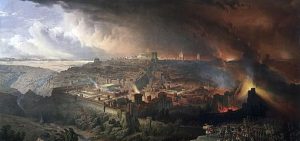Three Weeks Shiur

Entitled “A 17th of Tammuz Cholent,” it was, as the name implies, a little bit of this, and a little big of that. I think it was supposed to keep people awake in the long break between mincha and maariv at the Emek Learning Center on Emek Refaim. Includes thoughts from the Maharal, R. Kook, the Chasam Sofer, Beer Mayim Chayim, the Slonimer Rebbe, and others. Downloadable here.



Great shiur. (And thank you also for delivering it like a mensch, without bellowing breathlessly like a wounded buffalo. I guess they think it’s motivational or something. It only makes my neighbors want to call 911.)
I never know what to do with statements from the Maharal like the bais hamikdash was the nexus between heaven and earth, and that it’s destruction irrevocably changed the earth and the human condition for the worse. There is simply no indication of anything remotely like that happening in world history around the time the b”m was destroyed. In fact, by most standards, our lives have vastly improved since 500 b.c.
1) I would have bellowed like a wounded buffalo, but friends in the Berkeley branch of PETA warned me that this is considered today to be cultural appropriation. Only buffalo are allowed to bellow – and I respect that.
2) First of all, recognize that the changing of the human condition for the worse is not the Maharal’s prediction, but Chazal’s. They are the ones (and they lived much closer to it!) who state that there is no day whose curse is not greater than the one before. Maharal only offers the explanation. Within the Maharal, I don’t think he would preclude advances in civilization, both technological and even spiritual. (I would have a hard time believing that R Kook, who was so influenced by Maharal, could have written about a slow-growth spiritual advance (in certain ways) as part of the run-up to Mashiach. I can think of two ways that Maharal might argue that the constricting, as it were, of the conduit between heaven and earth affects life down here. One is the set of phenomena mentioned in the Mishnah in Sotah, i.e., the narrowing of various continua in nature, that led to the disappearance of some substances previously known to Man. There is nothing to suggest that those cannot be replaced by a growth in human understanding. (Indeed, a different piece of Maharal on projections of what life will be like in Messianic times predicts just that: the growth of human understanding will allow Man to accomplish the miraculous without changing any laws of nature, but by making use of them.) Another (and this is rank speculation) is that the improvement of our lives since the year 500 is not beyond cavil. Living longer, indoor plumbing, and proliferating iPhones do not necessarily improve lives on every index. The recent World Happiness Poll showed that some countries in South America, steeped in relative poverty and not know for their creature comforts, nonetheless show elevated levels of happiness. Meanwhile, the globe suffers from a pandemic of anxiety, obesity, disappearance of the nuclear family, and general malaise. Maharal could conceivably see these phenomena as consequences of disconnecting the world from its spiritual source.
Thank you for the helpful reply – your points are well taken.
“First of all, recognize that the changing of the human condition for the worse is not the Maharal’s prediction, but Chazal’s. They are the ones (and they lived much closer to it!) who state that there is no day whose curse is not greater than the one before.”
I still think that some of the rhetoric about the effect on the world of losing the B”M is often exaggerated/misunderstood and that even the words of Chazal are often allegorical and figurative. (“There is no day whose curse is not greater than the one before” is a case in point. It is clearly not historically literal and across-the-board.) I think (and I think you would agree) that the harm to the world reflects a much more subtle, nuanced, idea than is usually appreciated. The world didn’t simply plunge into a Dark Age after the churban.
“One is the set of phenomena mentioned in the Mishnah in Sotah, i.e., the narrowing of various continua in nature, that led to the disappearance of some substances previously known to Man.”
Yes. I would just add that this list couldn’t have been terribly extensive or significant, otherwise it’s impact on mankind would surely have been known to history.
In addition to R’ Kook and the Maharal, R’ Hirsch also notes the gradual spiritual progress in the world in his explanation of the korbanos brought on Succos. These ideas are also sadly underexplored/ignored in the yeshiva world.